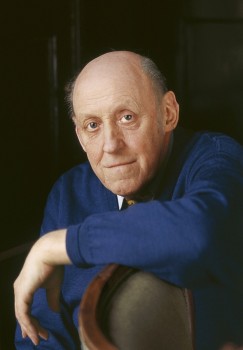In memoriam Bo Carpelan 1926–2011
24 February 2011 | Authors, In the news

Bo Carpelan. Photo: Irmeli Jung
I write one winter’s day,
write off the day and the night, the planets,
go into my house from a harsh sun
and extend those shadows that are swordlike aimed.
It is a day of drifting snow
and with a voice from that which is I
or was.
(From The Cool Day. English translation by David McDuff, published in Homecoming, Carcanet, 1993)
Bo Carpelan, one of the great names of Finnish literature, died in his home city of Helsinki on 11 February. Carpelan’s first collection of poetry appeared in 1946, his last in 2010.
In his poems and prose he frequently described his childhood in apartment buildings filled with the smell of cooked herring, the noise of quarrels and the sound of the news on the radio. Prosaic life is turned into poetry, images and music, the apartment house is built from the rooms of a dream.
Bo Carpelan loved music. His novel Axel (English translation by David McDuff, 1989), is about his paternal grandfather’s brother, who was a friend of Jean Sibelius and the composer’s first critic. Axel was an unsuccessful musician who chose to live through someone else, and Carpelan relates him to the theme of the dignity of rejected human beings.
Carpelan’s prose crossed the boundaries of art forms. Of Urwind (English translation, 1996) it has been said that there is probably no other novel which is at once theatre, art gallery, concert hall and film. The dizzying bliss of a dream and suffocating fear are what one can experience on the cinema screen or in a concert. Why couldn’t literature provide the reader with those things, Carpelan seems to be asking. Urwind’s central character, an old secondhand book dealer, sits in the concert hall of a dream and suddenly ends up in the place of the conductor, who has been taken ill. He raises his baton: ‘Three blows against the rock, a clear, proud stream of water flows out. Joy! The inexplicable reveals itself, formed to a single body, a hovering building, an innermost room.’
In his poems Carpelan seeks the experience that opens up in a short moment. He first mastered the poetry of landscape in his 1961 collection Den svala dagen (‘The cool day’), where he rejected metaphors and symbols, and approached reality with the techniques of the old Japanese masters. With quiet, concrete clarity he wrote about the core of perception, about people’s relations to their loved ones and to nature. In two collections which contain marginal notes on classical Roman verse he established a link to the oldest strata of poetry.
Although Carpelan wrote in Swedish, his life and writing were marked by a natural bilingualism: the Finnish translations of his verse are a central part of Finnish-language poetry, and Carpelan also translated Finnish poetry into Swedish. His own books have been translated into fifteen languages.
In recent years his novels were published simultaneously in Swedish and in Finnish. He received the Finlandia Prize for Fiction twice – in 1993, for Urwind, and in 2005 for Berg, as well as the Nordic Council Literature Prize in 1977 and Le Prix Européen de Littérature Award in 2007. Carpelan was a member of Books from Finland magazine’s editorial board from 1982 to 1986.
The melancholy of Carpelan’s prose works is often juxtaposed with a soaring flight across a landscape which reflects both outer reality and the inner world of the one who experiences it, bringing to mind the paintings of Piranesi, Magritte, or Brueghel. This will to transcend reality produces passages in Carpelan’s works that are reminiscent of some of the most startling and enigmatic details in the films of directors like Visconti and Buñuel. The Swedish Academy’s Horace Engdahl has called Carpelan ‘an architect of dreams’. The location of his last novels, which are set in a manor house in southern Finland, evokes the surrealism and spooky hallucinations of Ingmar Bergman’s films. There is also an echo of Bergman in Carpelan’s photography-related descriptive techniques which are aimed at capturing movement. In the images of his writing light streams inward, as in the paintings of Vermeer.
Carpelan is a master of imagery. His poetry wakens the memory to new life.
Translated by David McDuff
Tags: authors
Also by Pekka Tarkka
Tellervo Krogerus: Sanottu. Tehty. Matti Kuusen elämä 1914–1998. [Said. Done. The life of Matti Kuusi, 1914–1998] - 22 May 2014
In good company - 18 October 2013
Nationalism in war and peace - 3 May 2012
Arne Nevanlinna: Hjalmar - 5 November 2010
A day in the life of a bookseller - 12 August 2010
-
About the writer
Pekka Tarkka (born 1934) is an author and literary critic. Among his works are an extensive biography of the poet and writer Pentti Saarikoski (1937–1983) and of the author Joel Lehtonen (1881–1934; first volume, 2009; the second volume, 2012).
© Writers and translators. Anyone wishing to make use of material published on this website should apply to the Editors.
